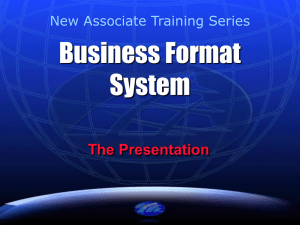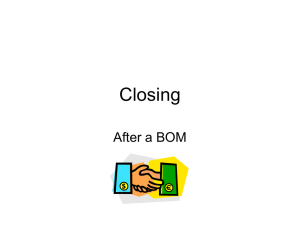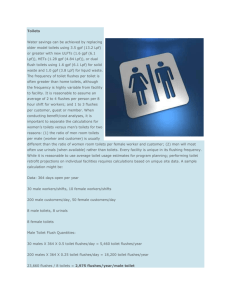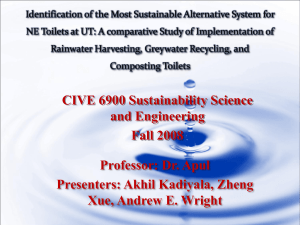1 - St. Eustatius
advertisement
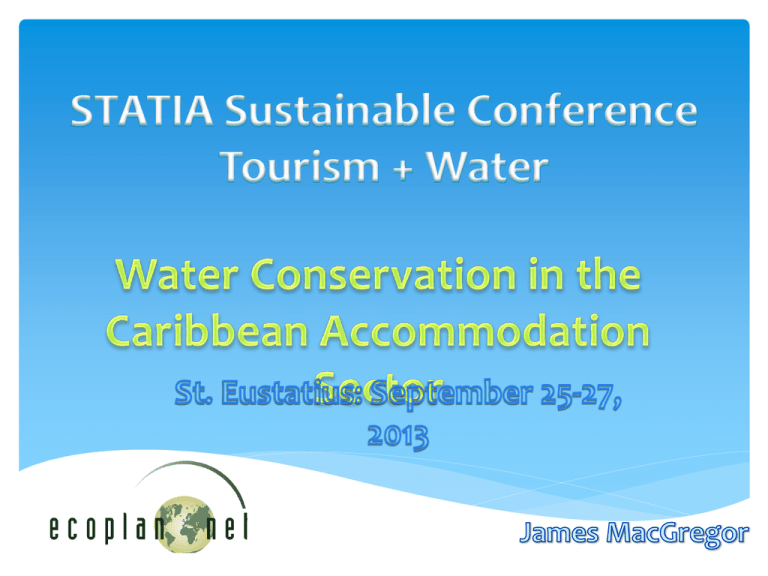
! 97% of water [ocean]; 3% freshwater: (2/3 in glaciers) 1% available for use, 1% is under threat 780 million without access to clean and safe drinking water, 2.4 billion lack access to basic sanitation Water demand will exceed supply by 40% in 2030 50% worlds population will live in water stressed regions Increased demand: growing global population, higher living standards, resource-intensive farming, Some countries, particularly islands, import fresh water with tank ships, including Bahamas, Antigua and Barbuda, Mallorca, the Greek Islands, South Korea, Japan, Taiwan, Nauru, and Fiji Maintain status quo and population of 9 Billion (2050); need 3.5 planet Earths to sustain a global population. While strong growth in water demand expected, available water resources will decline in many regions because of depletion of non-renewable fossil water resources pollution of water bodies and groundwater sources, climate change leading to declining precipitation levels in already water-stressed regions as a result of increased frequency of droughts, increased evaporation and changes in patterns of rainfall and runoff By 2020, significant tourism water use because: i) increase tourist numbers, ii) higher hotel standards and iii) Water-intense tourism activities. WTO Tourism 2020 Vision forecasts 1.6 billion international plus, 5 times the number of domestic trips (8 billion) Higher average hotel standards increase water use (spas, wellness resorts, swimming pools ,etc.) and greater indirect water demands for higher-order foods and an increase in average fossil fuel use per trip Altered precipitation patterns and changes in large-scale hydrological cycles include: 1. Regional changing precipitation patterns, changes in precipitation intensity and extremes, changes in soil moisture and runoff. 2. Increased precipitation in parts of the tropics, and decreases in sub-tropical and lower mid-latitude regions. 3. Increase in annual average runoff and water availability in some wet tropical areas, and decrease over dry regions at mid-latitudes and in the dry tropics. Impacts of Climate Change (2) 4. Increased precipitation intensity and variability are leading to greater likelihood of flooding and drought in many areas. 5. Higher water temperatures and changes in extremes floods and droughts, will affect water quality and exacerbate many forms of pollution. 6. Changes in water quantity and quality also affect food availability, stability, access and utilisation. COMMERCIAL: Water accounts for 10% of resort utility bills Consider both water purchase and disposal Reduced wastewater that must be treated Recent studies: water efficiency reduces water consumption by 50% ETHICAL: Resorts have a responsibility to use only what is absolutely necessary Ensure that island residents are not deprived of essential water needs Environmentally responsible thing to do Conserve island/community water resources Enhance public image Appeal to responsible tourist Offset or delay utility rate increases Reduce operating costs Avoid installing expensive desalination Last 30 years, water rates have increased faster than cost of oil. Savings will depend occupancy and age of facility Water efficient is a very effective way to improve their bottom line. Heating water uses energy, dish-washing and laundry operation; use more chemicals and detergents, equipment costs and other considerations. Accommodation type/location Water consumption: L/guest/day Apartment (Morocco) 180 L 3 star hotel or villa (Morocco) 300 4 star hotel (Morocco) 400 5 star hotel (Morocco) 500 Luxury 5 star hotel (Morocco) 600 Hotels/resorts (Sharm El Sheikh) 500 L 5 star hotels (Sharm El Sheikh) 1410-2190 L/room Hotels (Jamaica) 527-1596 L (average 980 L) All Hotels (Mediterranean) 440-880 L Large Hotels (Australia) 300 L (per room ) Resort Area Consumption Guestrooms F+B including kitchens Locker rooms, public toilets 35% - 50% 17% - 20% 16% - 18% Laundry Gardens and landscaping Pool 10%–15% 4% -6% 5% Guest rooms consume 40% - 50% of the total water Offer the most opportunities for conserving water. Typical water flow in guest rooms without compromising guest comfort or luxury. Showers…56% Toilet……. 25% Basin……. 09% Cleaning….10% Sources of Water Consumption Area Source of consumption Guest Rooms Toilets, Bathtubs, Shower heads, Faucets Office + Staff Areas Toilets, Urinals, Faucets, Shower Food Services Dishwashers, Pre-rise spray valves. Food steamers. ice machines, faucets Meeting Rooms Toilets, Urinals, Faucets Special Facilities Pools, Spas, Cooling Towers, Exercise Gyms Landscape irrigation Near buildings, parking lot medians, courtyards, recreation facilities Conservation ranges from 15 to 50%, most typically 15 to 35% Investment recovery period usually less than 4 years, normally less than 2.5 years Not uncommon to find measures which payback in less than 1 year Find out where you are before determining where to go. 3 steps to begin a program • 1. Understand the purpose and need for each water use at your facility, 2. Employees are your ears and eyes - they must be part of the process, and 3. If you don't measure it, you can't manage it. Some uses are vital to operation. Focus on future operational improvements Walk the facility, talk to employees; ways they use water: good way to discover leaks, malfunctions, etc. Where and when is water being used? How is it being used and by whom? Why is the water use necessary? Can amount be reduced by change in procedure? Way to accomplish the same thing without using water? Your eyes and ears; they use equipment that uses water Excellent source of information on cost effective ways to reduce all utility costs. Provide incentive to identify ways to reduce and providing them with utility costs Empower employees to become part of the solution. If only water meter is the one from the utility, finding "unexplained increase in water use" is difficult. Monitoring water use critical to good control water meters that are electronically connected to their central information system, Smaller hotels have employees read the water meter on a regular basis Plotting use on a daily basis will establish use patterns that will let know that there is a problem. Sub meters help manage water costs and identify costly problems in the various water using systems. Water savings potential varies depending on the type of facility and the how guests use the hotel Each hotel has different functions and water use patterns. Guest rooms not only area for potential water savings. Group functions to better understand how water is used, and the water conservation potentials within each group. Analyze all of the uses in an organized manner, while analyzing each building or facility according to its specific water use profile. Replacing older model (7 GPF) with efficient 3.5 GPF (13.2 LPF) or greater with new ULFTs (1.6 GPF (6.1 LPF)), HETs (1.28 GPF (4.84 LPF)), hundreds of HET models available Dual flush toilets using 1.6 GPF (6.1 LPF) for solid waste and 1.0GPF for liquid waste. Benefit-cost ratio is dependent upon the frequency of use; average of 6 to 7 flushes/guest Resort guests spend a larger portion of the day at the hotel; 4 to 6 flushes/day/guest Water level in the tank should be no higher than 1 inch below the top of the overflow tube. Flapper valves are the most common leakage problem. Leaks occur when the flapper valve does not create a water tight seal Sensor-activated flush mechanisms often result in more frequent toilet flushing than manual flush valves. Building maintenance staff: train to use the proper parts when servicing the flush valves Water Displacement Products Device to reduce amount water in tank for the flush, e.g., a toilet “dam” or displacement object (a bag, brick etc.). Used ONLY in toilets with flush volume of 3.5 gallons (13 litres) or above Early-Closing Toilet Flapper Original fully buoyant flapper replaced by a flapper with reduced buoyancy. causes the flapper to close flush valve before the tank is entirely evacuated of water, hence the term “early-closing”. early-closing flappers can achieve the desired 1.6 gpf 6.0 Lpf) flush volume. Dual-Flush Conversion Devices To retrofit single-flush gravity-fed fixture the products remove existing flush valve and replace with dual-flush valve. Many different products available Urinals replacing urinals depends on frequency of use and the type of replacement proposed calculate urinal flush per male employee 2 to 4 flush/day, urinal replacements; replacing the flush valve to reduced flows, replacing the entire fixture with high-efficiency urinal (HEU), including both flushing and non-water urinals. Showering leading use water: 17% -20% 1.2 trillion gallons of water used in US annually Standard showerheads use 2.5 gallons per minute Water–saving showerheads use 2.0 gpm and provide good experience. Incidents of accidental scalding have increased; caused by the loss of thermal buffering in water volume. Thermostatic mixing valves prevent this problem Some luxury’ resorts install multiple showerheads in guestroom shower stalls Replacing excessive flow showerheads, remove multiple showerheads are some of the most cost effective retrofits . Choose replacement showerheads with a high level of user satisfaction. $5 to $12 in bulk. Provide satisfactory shower that is equal to or better than conventional showerheads on the market Flow rates for wash basin faucets in lavatories can reasonably be reduced to 0.5 GPM (1.89 LPM) or lower. savings are usually based on usage frequency (toilet). Flow durations estimated to be 5 to 30 seconds per use Retrofitting aerators on the faucets is the most common and least expensive strategy The water savings are small when compared to replacing toilets cost of retrofit is minor, usually less than $1.00 per faucet. Leaks between the meter and the outlet in the water supply line. difficult to detect because it is usually buried. Sometimes leaking water travel along the pipe, back to the meter. If soil constantly damp might indicate a leak Faucet leaks are common occurrence and simple to repair. A faucet dripping slowly at only 1 drop every 2 seconds will waste 1,000 gallons + (3.7 m3) per year Toilets, showers, pool, kitchen Restaurants use water to create their products, as well as for cooling, cleaning, and sanitizing Restaurants, bars, nightclubs, banquet services and room service; presents excellent opportunities to conserve water in food preparation and dish washing. Water efficiency in hotel kitchen can be measured in litres/meal prepared (or restaurant patron) average 35 litres/ prepared meal Install pedal-operated tap controllers to ensure valves are closed when not in use. Cooking and warming devices have many opportunities for improved water efficiency: Combination ovens: use only 15 gallons of water per hour Install dry heating tables. instead of steam tables return and reuse condensate for all boiler-type steam kettles. size steam traps for proper operation to avoid dumping condensate. Insulate condensate-return lines. Use pasta cookers with a simmer mode and automatic overflow control valves. Restrict flow to a half a gallon per minute. Connectionless or boilerless steamers: consumes 3 Gal/Hr. Pre-rinse spray valves, Standard: 4 GPM (15.1 LPM) new efficient spray valves use only 1.2 GPM (4.5 LPM) and save hundreds of gallons per day (depending on volume and type of meals served) Ice machines (food and bar service facilities) use excessive amounts of water. Water use ranges between 18 to 20 gallons (68 L to 756.9 L) of water per 100 lbs (45.36 kg) of ice. Water efficiency would equate to 11.97 gallons (45.3 L) of water to produce 100 lbs (45.36 kg) of ice. Flake or nugget machines more energy-efficient than cube machines. Air-cooled units more water efficient; water cooled units more energy efficient The high cost of these water efficient machines often impairs the benefit-cost ratio of early replacement; When older dishwashers fail ,replace with high efficiency models Only wash with full loads of dishes Washing by hand, fill the sink rather than running tap. Don’t use running water to thaw frozen foods. Composting food waste reduces the water needed to run a garbage disposal. Laundering bedding and towels is a significant portion of water use. Each set of bed sheets requires 6 to 8 gallons of water to launder; Towel set (bath, hand and face) requires 6 to 8 gallons (22.7 L to 30.2 L). The most effective means to reduce water use encourage guests to re-use the sheets and towels (linen policy). Comparison of strategies: Improve laundry water efficiency may costs thousands of dollars and yield water savings of no more than 25%; guests re-using each towel and sheet set twice before laundering will yield water savings of 50% at a very minimal cost. Hotel towel and sheet reuse programs requires a cooperative effort from both the guests and the hotel staff. Promotion tent cards are placed in rooms and/or bathrooms to inform guests of: The precious value of water, need to conserve Asking guest assistance in re-using towels and sheets before laundering The procedures to reuse towels (hanging on towel rack usually indicates laundering not necessary) Reuse bed sheets (with guest request to housekeeping) Guests participate by following the instructions on the card Staff only removes, replaces towels and sheets as guest indicates Tent cards must be readily visible for the guests to notice Appeal to the guest must be effective to motivate Staff must also cooperate and follow the wishes of the guest; Housekeeping staff remove and replace towels even when the guests hang the towels Look for the lowest water factor available to achieve the highest water savings Evaluate costs and benefits for using laundry systems that recycle water or use ozone technology. May use wet methods, but NOT wasteful open hoses Install drains close to areas where liquid discharges are expected. Arrange equipment for easy use of a mop and squeegee system Install self-closing nozzles, limiting flow to 5 gpm on washdown Resorts can supplant potable water with reclaimed water use. Landscape irrigation most obvious opportunity Reclaimed water used to supply water to toilets and urinals. Cooling towers use reclaimed water rather than potable water. Clear separation of pipes supplying water to the end use (irrigation system, toilets, urinals, cooling tower, etc) from pipes supplying potable water to faucets, drinking fountains, etc Existing properties: water supply pipes (toilets/urinals) interconnected with faucets and kitchen; requires extensive plumbing system retrofits to reclaim water Retrofitting a pre-existing plumbing system usually too costly to justify the use of reclaimed water to flush sanitary fixtures. When constructing new buildings, the cost to separate the water supply pipes for sanitary fixtures is marginal. Regulations: new resorts be designed with dual plumbing so reclaimed water can be used to flush sanitary fixtures, irrigate gardens Adds less than 15% to the total cost of plumbing system. Collect rainwater on the building site (roof, parking lot, hardscape, landscape, etc.); one of the fastest growing strategies in water conservation industry and the “green” building efforts. Advantages to storm water collection and use: Collected water stored then used to irrigate the landscape during dryer months. Water collected is prevented from entering the storm water system, which is often overtaxed high rains. The pollutants from the resort site (fertilizers, herbicides, pesticides, animal waste, automobile fluids, etc) prevented from streams, rivers, and aquatic ecosystems. Xeriscape plan divides the landscape into water-use zones: High water-use zones, or oasis zones: highly visible, high maintenance areas of the landscape, such as the area around the entrance, patios where plants are watered regularly in the absence of rainfall. Moderate water-use zones, established plants watered only when they wilt or show other symptoms of moisture stress. Low water-use zones, plants watered by natural rainfall and would not be irrigated. Water conservation, design as much landscape as possible into low water-use zones. Choose plants : survive on normal rainfall or require minimal irrigation Existing native plant communities Non-native plants cultivated specifically for Caribbean conditions, are water-efficient and resistant to disease and pests Know each plant’s • Mature size (height and width) • Sun and shade requirements • Soil and Water needs • Salt and cold tolerances Turf areas and planting beds: separate irrigation zones. Separation allows for different irrigation schedules and different irrigation heads, such as pop-ups for turf, or drip heads for individual specimen plants such as shrubs or perennials Many of Caribbean plants have evolved through periods of extreme wet and then dry weather they survive through drought and don’t get root rot standing in water. developed defenses to the diseases, fungi and insects. tolerate the high winds during tropical storms and hurricanes. Strive to establish a landscape that is largely sustained ADD ORGANIC MATTER. This improves water retention of the soil and turf health. LESS FERTILIZER. Fertilization stimulates growth and increases water needs. If you fertilize, use a slow-release nitrogen product. Won’t wash away like liquid or fast-release fertilizers, which can contaminate waterways through stormwater or irrigation runoff. LEAVE GRASS CLIPPINGS. This reduces the lawn’s need for both water and fertilizer. RAISE THE HEIGHT OF LAWN MOWER BLADES TO THE HIGHEST SETTING. Remove no more than 1/3 of the leaf blade. Cutting grass shorter stress the grass and decrease the depth to which roots will grow, increasing the need for water. KEEP A SHARP CUTTING EDGE. Sharp mower blades give a clean cut. Grass torn and shredded by dull blades suffers stress, requiring more water. CONSIDER ALTERNATIVES TO GRASS. Grass can be a useful plant. Use grass in areas where guests concentrate or play or for erosion control. LOW-USE AREAS, consider drought tolerant plant beds, groundcovers, mulch, walkways or other alternatives that require little or no water. System must apply water uniformly over the desired area with minimum of over-spray into adjacent areas CHECK THE APPLICATION RATE OF SPRINKLER SYSTEM. Rate which a sprinkler system applies water to the soil surface, measured in inches per hours (in/hr). If application rates exceed the absorption capacity of the soil, then runoff occurs. Rotary sprinklers application rates: 0.25 to 0.50 inches per hour and rarely cause runoff. Spray heads typically have application rates between 1 and 2 inches per hour and may cause runoff on heavy soils slopes are greater than 10 percent AUTOMATIC CONTROLLER SAVES WATER. Turns the system on and off and controls the water flow through the various zones according to a pre-set time clock. It allows you to set the length of time each zone operates as well as the days of the week and time of day the system operates. Automatic controller still requires monitoring Re-program frequently during the growing season because water needs Rainfall sensor detects rainfall and prevents the irrigation system from operating if significant rainfall has occurred. Soil moisture sensor measures and overrides the system when soil moisture is adequate. Sensors useful if the system cannot be monitored and adjusted regularly. ADJUST SPRINKLER HEADS AS NEEDED. Improper adjustment of sprinkler heads not only wastes water and may damage buildings Adjust the radius and arc of part-circle sprinklers to prevent undesirable over-spray. Check the system several times during the year to ensure proper adjustment. OPERATE SPRINKLERS BETWEEN 4 P.M. AND 10 A.M. Least amounts of sunlight and evaporation occur during these hours. HANDWATERING: Effective and efficient way of applying water to selected plants that show signs of stress during dry periods., Applied slowly enough to be absorbed by the soil, uses less water and is more efficient than sprinkler irrigation IRRIGATE TURFGRASS : 1 to 1 1/2 inches/week during hot, dry weather. It is usually best to divide this amount into 2 applications/week NEVER WATER GRASS DAILY; Daily irrigation with a small amount of water encourages shallow root system and reduced drought tolerance Mulching most beneficial landscape practices: conserve moisture by preventing evaporation from the soil surface and reducing the need for supplemental irrigation during periods of limited rainfall. Maintains even moisture supply in the soil: prevent fluctuations in soil moisture that damage roots. Mulches also prevent crusting of the soil surface and allow water to penetrate readily to plant roots. Insulates roots from summer heat and help control weeds that compete with plants for moisture. Barrier between the plant and soil discourage soil-borne diseases that stress plants and cause a higher demand for water. Mulch beds are an economical way to retrofit an existing landscape by reducing water needs and maintenance requirements, unplanted mulched areas require no water Pine straw, melaleuca mulch, recycled yard waste and shredded hardwood mulch or chips are some of the best mulches. They hold moisture in the soil better than course-textured mulches Avoid inorganic mulches; rock, gravel and marble absorb heat from the sun and increase water loss from plants and soil Xeriscape landscape is a low-maintenance landscape Fertilize less and use slow-release fertilizers. Leaving grass clippings: supplies recycled nutrients and reduces the need for supplemental fertilizer. Proper mowing saves water: raising the mower blade during dry weather and cutting the grass higher encourages deeper rooting Employees to feel part of a water-efficient organization when clear, accurate information about importance of saving water for the business and community. Build water saving knowledge and staff commitment Training that emphasizes importance of saving water in daily work activities. Familiarize team with the water-using systems Involve employees in decision making. Seek suggestions on ways to reduce consumption. Acting without consultation discourages participation. ‘suggestion’ box in staff area that asks for water saving suggestions. Advise staff in advance of new water saving initiatives and retrofits. Informed staff; more qualified to act as water efficiency ambassadors to your guests. Obtain commitment and set targets through weekly meetings with public announcements. Develop prompts with vivid, personal and concrete messages on water conservation and place in strategic locations: e.g. Kitchen, staff rooms Remind staff to avoid running taps when rinsing dishes and vegetables. Employees are your eyes and ears. Front-line roles: positioned to identify leaks, unnecessary water use and other water wastage and provide water efficiency advice. Report results and let employees know when their efforts have contributed to water savings that benefit the business and environment. When engaging or briefing contractors or maintenance personnel: Emphasize the importance of saving water while they are working in your hotel. Ensure they include water as a KPI (Key Performance Indicator), when introducing new systems, repairing old equipment or upgrading your facilities. Include a prompt in your communication pieces that emphasizes commitment to water conservation. On arrival, inform guests about the islands current water status and the importance of conserving water. Most visitors to the Caribbean are not aware of water shortages Create prompts in guest rooms, bathrooms, public areas about conserving water during stay. Create signs or posters to inform guests about what you are doing to conserve water. jmacgregor@ecoplannet.com



